Found a total of 10000 related content

mac os terminal commands for beginners
Article Introduction:pwd displays the current location, ls view the file, cd switches the directory; 2. touch creates empty files, mkdir creates folders, rm deletes files or -r deletes folders, mv renames or moves, cp copy files; 3. cat view content, open with default application, nano edits text; add Tab completion, ↑ checks history, Ctrl C termination, man checks help, and gradually practice to use Terminal proficiently.
2025-07-23
comment 0
291
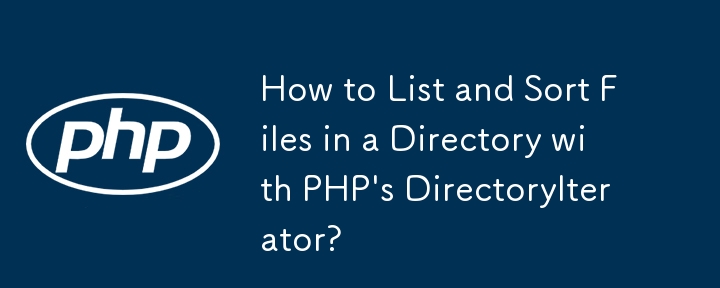

python shutil rmtree example
Article Introduction:shutil.rmtree() is a function in Python that recursively deletes the entire directory tree. It can delete specified folders and all contents. 1. Basic usage: Use shutil.rmtree(path) to delete the directory, and you need to handle FileNotFoundError, PermissionError and other exceptions. 2. Practical application: You can clear folders containing subdirectories and files in one click, such as temporary data or cached directories. 3. Notes: The deletion operation is not restored; FileNotFoundError is thrown when the path does not exist; it may fail due to permissions or file occupation. 4. Optional parameters: Errors can be ignored by ignore_errors=True
2025-08-01
comment 0
317

C language data structure: data representation and operation of trees and graphs
Article Introduction:C language data structure: The data representation of the tree and graph is a hierarchical data structure consisting of nodes. Each node contains a data element and a pointer to its child nodes. The binary tree is a special type of tree. Each node has at most two child nodes. The data represents structTreeNode{intdata;structTreeNode*left;structTreeNode*right;}; Operation creates a tree traversal tree (predecision, in-order, and later order) search tree insertion node deletes node graph is a collection of data structures, where elements are vertices, and they can be connected together through edges with right or unrighted data representing neighbors.
2025-04-04
comment 0
1605

What is a file system library in C 17?
Article Introduction:The C 17 file system library provides a unified, type-safe interface, making file and directory operations more intuitive and efficient. 1) The std::filesystem::path class simplifies path operation; 2) The std::filesystem::directory_iterator facilitates traversing directories; 3) Pay attention to exception handling and performance optimization to ensure the robustness and efficiency of the program.
2025-04-28
comment 0
1054

PHP gets a list of directory files and uses it in JavaScript
Article Introduction:This article will introduce how to use PHP to obtain the file names of all files in a specified directory and pass these file names into JavaScript code as an array. Read the directory through PHP's file operation function, then convert the PHP array into a JSON string using the json_encode function, and finally parse the JSON string in JavaScript, thereby realizing the passing and use of file names.
2025-08-21
comment 0
880

How to use yii framework
Article Introduction:Free and open source PHP Web Framework Yii Getting Started Guide Installation Prerequisites: PHP 7.2, Composer Create Application: composer create-project yiisoft/yii2-app-basic your-app-name Project Structure: Contains assets, config, controllers, models, runtime, views, web, etc. Create Controller: Create classes in the controllers directory, such as SiteController, define operation methods and create models: In models
2025-04-18
comment 0
820
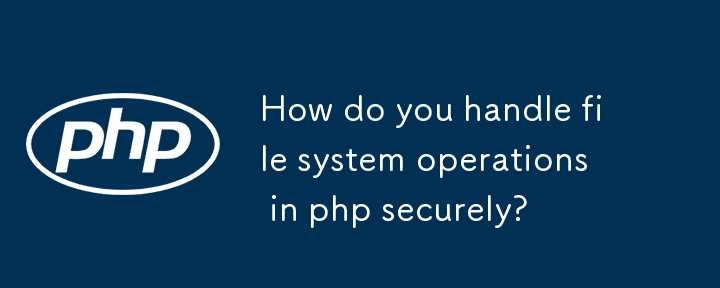
How do you handle file system operations in php securely?
Article Introduction:To safely handle file system operations in PHP, first of all, you need to verify and clean all user input, use basename() to extract file names, avoid directly allowing users to input paths, and check whether the input meets expectations through regular expressions; secondly, restrict files to access a secure directory, you can compare the allowable paths by using realpath() in the open_basedir configuration or code; thirdly, set correct file and directory permissions, recommend 0755 directory and 0644 file permissions, avoid using 0777; fourthly, use PHP built-in functions to process files to avoid executing shell commands; finally record and monitor file operation behavior to discover abnormal activities. These steps can effectively prevent unauthorized access and data loss
2025-07-10
comment 0
173

Working With URIs in Laravel
Article Introduction:Laravel 11.35 introduces the Uri class based on the PHP League URI library. Uri simplifies the process of manipulating and processing URIs in Laravel applications and provides some convenient features about named routing.
Basic Operation
The core function of the Uri class is to create and manipulate URI strings, including queries, fragments, and paths:
use Illuminate\Support\Uri;
$uri = Uri::of('https://laravel-news.com')
->withPath('links')
->wit
2025-03-05
comment 0
840

How do I fix 'Autoload error' after installing packages with Composer?
Article Introduction:When encountering Composer's "Autoloaderror", the first thing to do is to clarify the core of the problem: PHP cannot find the required class through automatic loading. The following are the solutions: 1. Run composerdump-autoload to regenerate the automatic loading file, and clear the cache if necessary; 2. Check whether the case of the class name and file path match, especially on case-sensitive systems; 3. Check the PSR-4 automatic loading configuration in composer.json to ensure that the namespace and directory path are correct; 4. Try to uninstall and reinstall the problem package or clean the vendor directory and then reinstall it; 5. Troubleshoot duplicate class names or conflicting files. In most cases
2025-08-05
comment 0
624
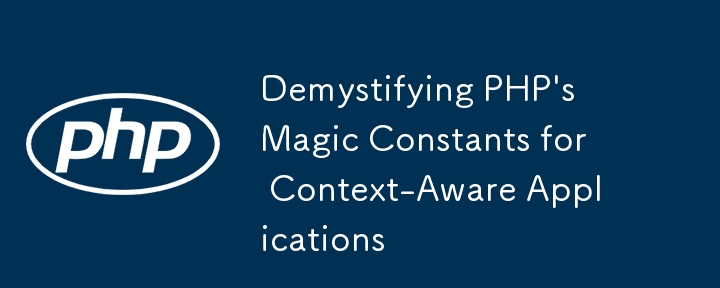
Demystifying PHP's Magic Constants for Context-Aware Applications
Article Introduction:The seven magic constants of PHP are __LINE__, __FILE__, __DIR__, __FUNCTION__, __CLASS__, __TRAIT__, __METHOD__, and they can dynamically return code location and context information, 1. LINE returns the current line number, for precise debugging; 2. FILE returns the absolute path of the current file, often used to reliably introduce files or define root directory; 3. DIR returns the directory where the current file is located, which is clearer and more efficient than dirname (__FILE__); 4. FUNCTION returns the current function name, suitable for function-level log tracking; 5. CLASS returns the current class name (including namespace), in logs and factories
2025-07-30
comment 0
961

How to run PHP scripts?
Article Introduction:To run a PHP script, you need to select the appropriate environment according to the purpose. 1. Local operation: Use integrated packages such as XAMPP, WAMP or MAMP to build an environment, put the PHP file into the http://localhost/yourfile.php through the browser to execute; Linux users can check and install PHP with sudoapt. 2. Command line operation: It is suitable for automation tasks, ensure that after PHP is added to PATH, enter the script directory in the terminal and execute phpscript.php. 3. Online testing: Quickly test code snippets through platforms such as 3v4l.org, phptester.net, etc., suitable for learning and sharing, but not for development of complete
2025-06-29
comment 0
837

How to autoload classes in php
Article Introduction:Using Composer and PSR-4 is the recommended way to automatically load classes for PHP. The namespace and directory mapping is defined through composer.json, and the automatic loader is generated by running composerdump-autoload. The class file can be automatically loaded by introducing vendor/autoload.php into the entry file, without manual inclusion, improving code maintainability.
2025-08-24
comment 0
990

Suggesting Carbon with Composer - Date and Time the Right Way
Article Introduction:Carbon: PHP date and time processing tool
Carbon is a lightweight PHP library for simplifying the processing of dates and times. It is based on and extends the core DateTime class and adds many convenient methods to make date-time operation easier. This article will introduce the basic usage of Carbon and demonstrate how to use it in a real project.
Core points:
Carbon is a library designed for PHP date and time operations, extends the core DateTime class and adds user-friendly methods to provide a more intuitive experience.
The library can be installed using Composer and can be instantiated from strings, timestamps, or other DateTime or Carbon instances
2025-02-16
comment 0
536

PHP gets a list of directory files and uses it in JavaScript
Article Introduction:This article will introduce how to use PHP to read all file names in a specified directory and pass these file names to JavaScript code for use. Through PHP's file operation functions and JSON encoding, we can easily obtain file lists on the server and use JavaScript to further process them on the client, such as dynamically displaying file lists or performing other related operations.
2025-08-21
comment 0
812
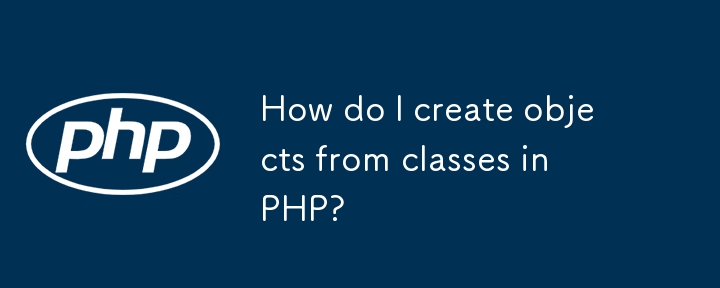
How do I create objects from classes in PHP?
Article Introduction:To create an object in PHP, you must first define the class and then instantiate it with the new keyword. 1. Classes are blueprints of objects, defining attributes and methods; 2. Create object instances using new; 3. Constructors are used to initialize different data; 4. Access attributes and methods through ->; 5. Pay attention to access control of public, private, and protected; 6. Multiple independent instances can be created, each maintaining its status. For example, after defining the Car class, newCar('red') creates an object and passes a parameter, $myCar->startEngine() calls the method, and each object does not affect each other. Mastering these helps build clearer, scalable applications.
2025-06-24
comment 0
872

What are some best practices for securing PHP sessions?
Article Introduction:The security of PHP sessions can be achieved through the following measures: 1. Use session_regenerate_id() to regenerate the session ID when the user logs in or is an important operation. 2. Encrypt the transmission session ID through the HTTPS protocol. 3. Use session_save_path() to specify the secure directory to store session data and set permissions correctly.
2025-05-01
comment 0
1074
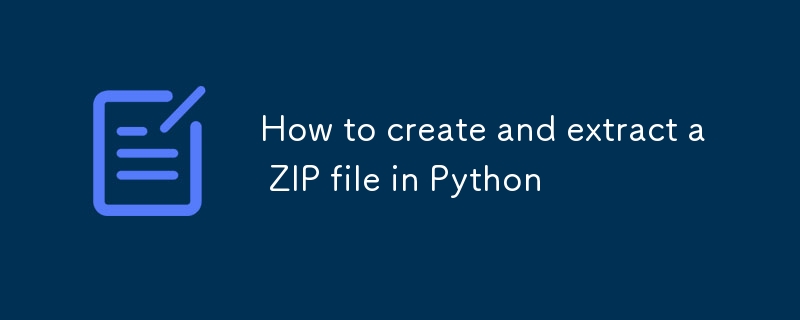
How to create and extract a ZIP file in Python
Article Introduction:Using the zipfile module in Python can directly create and decompress ZIP files. 1. To create a ZIP file, you need to use the ZipFile class to open the file in write mode, and add the file through the write() method. When packaging the directory, you need to traverse the file recursively and pay attention to the path processing; 2. Unzip the ZIP file to restore the complete directory structure by extractall() method, or you can also selectively extract a single file after viewing the content through namelist(); 3. Other techniques include handling Chinese garbled code, detecting whether the ZIP is corrupt, setting compression levels and password protection (requiring a third-party library). Mastering these key points can meet daily ZIP file operation needs.
2025-07-21
comment 0
186

How do I install the dependencies listed in my composer.json file? (composer install)
Article Introduction:The most direct way to install dependencies is to run composerinstall. The specific steps are as follows: 1. Make sure that Composer is installed, and you can check the version through composer--version; 2. Enter the project root directory and execute composerinstall. This command will install dependencies based on composer.json and composer.lock, generate automatic loading configurations and store them in vendor/directory; 3. You can use --no-dev to skip development dependencies, -o optimization class loader, --prefer-dist priority download of zip files, etc. to enhance control; 4. If the installation fails, common reasons include incompatible PHP versions and lack of extensions
2025-07-16
comment 0
583
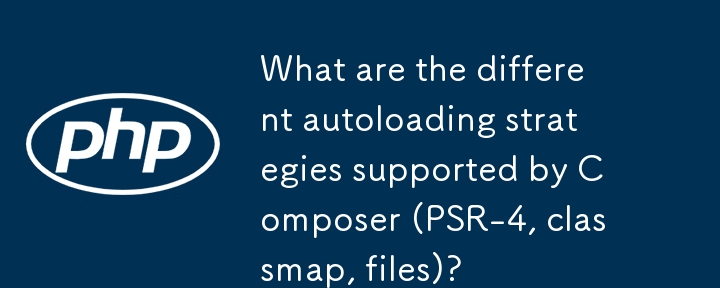
What are the different autoloading strategies supported by Composer (PSR-4, classmap, files)?
Article Introduction:Composer's automatic loading strategies are mainly three: PSR-4, classmap and files. 1. PSR-4 is suitable for modern PHP projects that follow namespace specifications. It automatically loads by mapping namespaces to directories, supports subdirectories and does not need to list files manually; 2. classmap is used to load classes that do not comply with PSR-4 naming specifications, such as legacy code or multi-class files. Composer will scan the mapping table of the specified directory to generate class names to paths, and needs to run composerdump-autoload after adding or renaming the class; 3. files are used to explicitly include PHP files that need to be loaded unconditionally at each request, suitable for defining global functions,
2025-08-12
comment 0
240



















